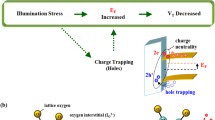Abstract
Optical transient current spectroscopy (OTCS) involves observing the transient decay of “photoconductivity” and is of interest as a means of characterizing semi-insulating GaAs wafers. We report experimental results which show that the OTCS spectrum and, in particular, the occurrence of negative peaks is strongly dependent on the shape, size and electrode configuration of the specimen, as well as on the magnitude of the applied voltage and (with asymmetric electrodes) its polarity. A negative peak sometimes changes to a current oscillation with increasing voltage, probably indicating field enhanced trapping. Negative peaks may be observed with sandwich structures with a transparent electrode covering the illuminated surface. This shows that a recent proposal that surface states are involved is at least not always correct. It is suggested that several mechanisms can give negative peaks, and probably more than one has done so under the various experimental conditions which have been used. The present work shows that any practical application of OTCS for ingot qualification will be dependent on standardization of specimen geometry, electrodes and operating parameters.
Similar content being viewed by others
References
G. M. Martin and D. Bois, Proc. Electrochem. Soc., Semi-conductor Characterization Techniques, Edtr. P. A. Barnes,78, 32 (1978). The acronym PITS (photoinduced transient spectroscopy) is also used but OTCS, has the advantage of indicating that a current transient is involved. PICTS (photoinduced current transient spectroscopy) (2) is better in this respect. The technique known as optical DLTS (3) does not represent OTCS but a capacitance DLTS technique in which a light rather than a voltage pulse is used.
J. Rhee and P. K. Bhattacharya, J. Appl. Phys.53, 4247 (1982).
S. K. Brierly, J. Appl. Phys.61, 567 (1987).
D. V. Lang, J. Appl. Phys.45, 3023, (1974).
C. Hurtes, M. Boulou, A. Mitonneau and D. Bois, Appl. Phys. Lett.32, 821 (1978).
M. Ogawa, T. Kamiya and H. Yanai, Inst. Phys. Conf. Ser., GaAs and related compounds63, 571 (1981).
L. Young, W. C. Tang, S. Dindo and K. S. Lowe, J. Electrochem. Soc.133, 609 (1986).
S. R. Blight, A. D. Page, P. H. Ladbrooke and H. Thomas, Jpn. J. Appl. Phys.26, 1388 (1987).
S. R. Blight and H. Thomas, J. Appl. Phys.65, 215, 1989.
R. E. Kremer, M. C. Arikan, J. C. Abele and J. S. Blakemore, J. Appl. Phys.62, 2424 (1987).
J. C. Abele, R. E. Kremer and J. S. Blakemore, J. Appl. Phys.62, 2432 (1987).
Z. Fang, L. Shan, T. E. Schlesinger and A. G. Milnes, Solid-State Electron.32, 405 (1989).
C. C. Tin, C. K. Teh and F. L. Weichman, J. Appl. Phys.62, 2329 (1989).
J. C. Bourgoin, H. J. Von Bardeleben and D. Stievenard, J. Appl. Phys.64, R 65 (1988).
O. Yoshie and M. Kamihara, Jpn. J. Appl. Phys.24, 431 (1985).
M. Kaminska, J. Parsey, J. Lagowski and H. Gatos, Appl. Phys. Lett.41, 989 (1982).
C. Backhouse and L. Young, J. Electrochem. Soc.138, 3759 (1991).
A. B. Torrens and L. Young, Can. J. Phys.50, 1098 (1972).
T. K. Battacharya, Jpn. J. Appl. Phys.9, 1268 (1970).
H. K. Sacks and A. G. Milnes, Int. J. Electron.28, 565 (1970).
Y. Tokumaru, Jpn. J. Appl. Phys.8, 95 (1970).
G. N. Maracas, D. A. Johnson and H. Goronkin, Appl. Phys. Lett.46, 306 (1985).
F. Wager and A. McCamant, IEEE Trans. Electron Dev.34, 1001 (1987).
Z. M. Li, S. P. McAlister, W. G. McMullan and C. M. Hurd, J. Appl. Phys.67, 7368 (1990).
Z. M. Li, D. J. Day, S. P. McAlister and C. M. Hurd, IEEE Electron Device Lett.11, 342 (1990).
G. Maracas, W. Porod, D. Johnson and D. Ferry, Physica134B, 276 (1985).
D. Hui, Ph.D. Thesis, Univ. of B.C., Vancouver, Canada (1990).
Author information
Authors and Affiliations
Rights and permissions
About this article
Cite this article
Hui, D., Kato, H., Backhouse, C. et al. Effects of electrode geometry and polarity on the occurrence of negative peaks in optical transient current spectroscopy applied to semi-insulating gallium arsenide. J. Electron. Mater. 21, 901–909 (1992). https://doi.org/10.1007/BF02665547
Received:
Issue Date:
DOI: https://doi.org/10.1007/BF02665547




